When it comes to identifying edible green plants I do all right. But with mushrooms I am a rank amateur. So it was with great glee that I found a “choice” wild mushroom, a Blewit, or Lepista nuda. At first glance it looked like the plastic top of some discarded can under a vine but upon investigation it was a large, beautiful mushroom. To be sure I took it back to the EarthSkills gathering for confirmation. Several hundred folks were camping out about 20 miles south of Gainesville — I taught on site the day before — and there were several mushroom experts in attendance. That was my first mistake. I thought I was safe there. Was I wrong. Have you ever been mugged for a mushroom? There were many offers to take it off my hands but it went home with me and into me. After years of finding non- or barely-edible mushrooms it was my turn to discover a choice one. And you can bet I will be revisiting that site again.
As if the tasty mushroom was not enough, this week also found my classes discovering Wild Garlic. A native that is about six inches high now but will be blossoming in a few weeks then setting cloves. What makes this Allium curious is that it puts a bulb on at the bottom end and cloves at the top end. This particular species is very pungent. It’s great for cooking or as a trail side nibble as long as you don’t mind strong garlic breath. Before it blossoms the entire plant can be used to make a very nice soup. Oddly there’s no record of southeastern natives using the plant and only three tribes had names for it. I call it good.
Botany Builder #38: Terminal. No, botanically it does not mean dead. Technically it means at the end of an axis. I just think of it as the end of a branch. A good example throughout North America are the edible Sumacs. They have terminal clusters of flowers which later turn to berries. “Terminal” is from the Dead Latin Terminus, meaning the end. It is from a Roman god of the same name that protected boundaries (usually as a bust on a post.) Historical note: The city of Atlanta used to be called Terminus because that was where the railroad stopped.
Plantago Power: It was a dark and rainy … morning… and I was searching through the gloom along the road for a wild mustard/radish for my foraging class. It was cold. It was rainy. It was gray. Something caught my eye so I pulled Van Go over and headed towards a watery ditch. Then I heard a baby cry. Seriously. The figure I thought was a bag lady with stuffed shopping cart was a bundled-up woman with a baby stroller waiting for a bus. Things look different in the dim drab of winter. And the plant I thought might be a mustard most certainly was not. It was a Plantago, the largest one I have ever seen. That was worth a picture and posting on the Green Deane Forum. There one of our regular members, Josey, who has an eye for detail and a whole lot of knowledge, offered it as Plantago Rugelii rather than P. major. One difference is the P. rugelii has purple at the base of the petiole, P. major is white. Unlike P.major, which is from Europe, P. rugelii is native to North America. It is odd that we don’t hear more about it.
Guest Article: When I moved into my neighborhood 14 years ago there were several large Mango trees, and still are. I have planted several Mangos since then but the winters have killed them. The established neighborhood Mangos have tolerated the cold weather, so far. Conversely I have a Star Fruit behind the house that has survived nicely though it is 50 miles north and 50 miles east of its last commercial location and not recommended for this area. State Road 50 cuts across the middle of Florida. There used to be large citrus groves north of SR50. Now there is said to be none, and no funding for any new ones. Most of that rolling acreage is now housing developments. It would seem temperatures are changing. Whether there is global warming or not, or why, is not well-wrought science. It depends upon who is measuring and with what. In the 1950’s two US submarines (Skate and Nautilus) met and surfaced at the north pole in open water. It was a warm period. That said I can well remember the… heated… debate in the early 70’s on whether the north and south poles were getting too cold. The world was dramatically cooling according to an April 1974 Newsweek article, an unimaginable disaster in the making requiring immediate action. One plan included spraying the snow and ice with black dye to warm things up. Perhaps in that case it was good that government is slow and incompetent. In this article, Is It Really Global Warming?, Mike Conroy takes a look at the issue and it impact.
For years we have been inundated with media reports from select scientists saying it is global warming. The ice caps are melting. Glaciers are disappearing. Global temperatures are rising to “unprecedented” levels. And soon coastlines will be flooded, crops will fail, floods will spread across deserts and deserts will spread across croplands.
But is it really global warming? Now let me say that I am in favor of reducing pollution, limiting our impact on natural processes, and maintaining the diversity of nature. To do otherwise is, at best irresponsible. We have seen the effects of man on nature in the last hundred years or so. DDT nearly caused the extinction of the California Condor and decimated the eagle populations throughout the USA. Toxic “spills” have caused local birth defects in both humans and animals. And who knows what other problems our pollution has caused?
But is it really global warming? Historically, we have been able to monitor the global ice packs since around 1950 when the space program allowed us to view the ice packs from above; and sure, since then, the ice caps have shrunk. Other historical data from ice core samples and geological studies have indicated that the earth was colder in times past. But why such a sudden change in world temperatures today? After all, 60 short years of time has passed in which we have observed the “destruction” of polar ice. And in perspective, in geological time, 60 years is only a moment.
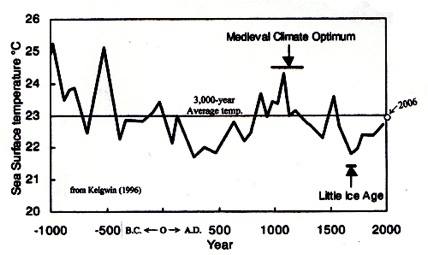 But is it really global warming? Nature and natural phenomena swing. There are periods of drought followed by periods of rain. There are periods of warmth followed by periods of cold. There are periods of wind followed by periods of calm. This happens hour by hour, day by day, week by week, season by season, century by century, and millennium by millennium. There were the ice ages, followed by warmth. And more recently, there was the Medieval Climatic Optimum (MCO), or Medieval Warm Period (MWP) if you prefer to call it that, followed by the Little Ice Age (LIA). And the MWP happened a mere thousand years ago. Temperatures were not very different from what they are today. Or were they? There remains much debate on this subject in the scientific circles.
But is it really global warming? Nature and natural phenomena swing. There are periods of drought followed by periods of rain. There are periods of warmth followed by periods of cold. There are periods of wind followed by periods of calm. This happens hour by hour, day by day, week by week, season by season, century by century, and millennium by millennium. There were the ice ages, followed by warmth. And more recently, there was the Medieval Climatic Optimum (MCO), or Medieval Warm Period (MWP) if you prefer to call it that, followed by the Little Ice Age (LIA). And the MWP happened a mere thousand years ago. Temperatures were not very different from what they are today. Or were they? There remains much debate on this subject in the scientific circles.
But is it really global warming? Today, global warming is a “phenomena” of warmer global temperatures blamed on man and mankind’s abuse of the planet. But what had caused the MWP? The industrial age had not yet happened and the population of people was much smaller. So, our pollution had much less effect on the global temperatures. So does mankind cause global warming? And what of the scientific concerns of the 1970’s when global cooling and a hole in the ozone were the issues of the day? By the way, the hole in the ozone began shrinking almost as soon as it was discovered, so you hear little about it today. So, is it really global warming, or just a natural shift in nature? For me, the jury is still out on this one. But I still think we should take care to keep our home and our planet clean and healthy. After all, who wants to poison ourselves with toxins in the foods we eat? But, is it really global warming?
Why is it important to understand this “phenomena”? Simply put, a warming (or cooling) planet, regardless of its cause, changes the local weather conditions in any given area. And the local weather makes a difference on what plants will grow. This impacts not only crops, but also the makeup of local fauna. For example, in England, grapes during the MWP grew hundreds of miles further north than their current range. This will change the foraging opportunities in our individual regions. What once grew in our neighborhoods may no longer be there. And foraging books for a given region may no longer be accurate for that region. Yet, plants are mobile. Not any individual plant, but as a species. They spread their seed, often far and wide. So in the future, if it is really a long-term event, we may have to adjust our foraging knowledge. But again, is it really global warming, or just a blip in the long term weather?
Mike holds a B.S., C.I.S., with a minor in Aquaculture from Lincoln University. If you would like to submit a short article about wild edible plants to the Newsletter please contact Green Deane via the newsletter’s email address.
Foraging class schedule this week: Saturday, February 15th, Bayshore Live Oak Park, 23000 Bayshore Rd., Port Charlotte, FL, 33980, 9 a.m. Sunday, February 16th, Dreher Park, 1200 Southern Blvd. West Palm Beach, FL, 33405, 9 a.m.
This is a reminder the Florida Herbal Conference 2014 will be held in Deland in late February. Featured speaker Friday evening is David Winston, an herbalist and ethnobotanist with over 40 years of training in Cherokee, Chinese and Western herbal traditions. He has been in clinical practice for over 34 years and is an herbal consultant to physicians, herbalists and researchers throughout the USA and Canada. Also for the third year in a row I will be leading weed walks at the conference. Although it is the Florida Herbal Conference it draws teachers and students from all over North America. Two other Florida “locals” will be teaching classes besides the scheduled main speakers. They are Andy Firk, who holds a wide variety of workshops throughout the year at his “Bamboo Cove” in Arcadia, and Earthskills’ past host Mycol Stevens of Gainesville.
Though your foraging may drop off during the winter it’s a great time to study wild edibles with my nine DVD set. Each DVDs has 15 videos for 135 in all. They make a great gift. Order today. Some of these videos are of better quality than my free ones on the Internet. They are the same videos but many people like to have their own copy. I burn and compile the sets myself so if you have any issues I handle them personally. There are no middle foragers. And I’m working on adding a tenth DVD. To learn more about the DVDs or to order them click here. I also uploaded a new video to You Tube recently. This one is about Cereus fruit. It is not on the DVDs but you can see it here.
What Do You See #2. Can you find four edible species in the photo directly below? They are common in the spring or summer, depending where you live. Here they show up in winter. The fourth one is a relatively warm-weather plant that most won’t recognize though it is seeding in our cooler winter temperatures. The answer will be published here next week or you can read it now on the What Do You See? board in the Green Deane Forum. Further below is the answer to last week’s What Do You See? #1
What Do You See? #1: In last week’s the picture (below) there are three different, common edibles species. There a fourth lesser known and possibly five. Number One is Spiny Sow Thistle, Sonchus asper. It’s a very common spring and summer potherb. It is not as choice as its relative, Sonchus oleraceus, but when young is very good. Number Two is Poor Man’s Peppergrass, Lepidium virginicum. In this picture it is at several stages of growth. From left to right it is under the 2 on the left. Between the 2 and 6. It’s above the third 2 and to the right of the fourth 2. Number 3 is some cold weather purslane, Portulaca oleracaea, which some consider the most nutritious green on earth. Number 4 is Pony Foot, or Dichondra caroliniana. While edible in salads and the like it is very bitter and considered more a medicine, a “liver tonic.” Number 5 is ragweed, Ambrosia. Not edible but it’s seed oil is. Number six is a cudweed, a Pseudognaphalium. Cudweed is very commom this time of year locally and can confound a lot of new foragers. Not edible but some members of the species have medicinal uses.

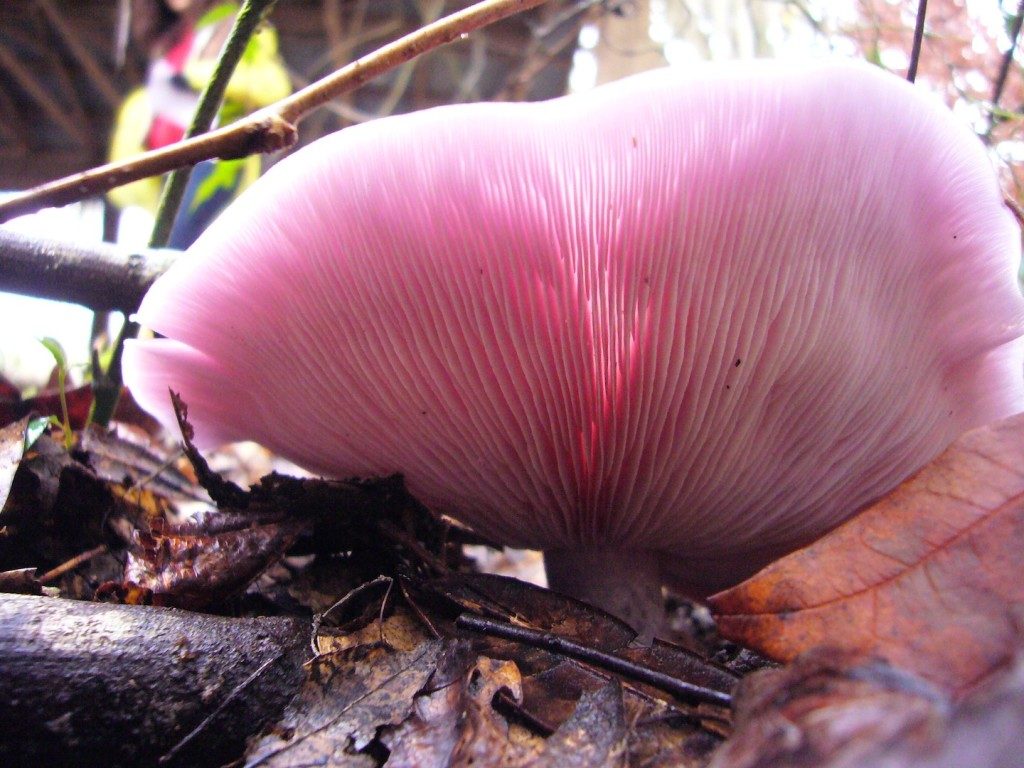
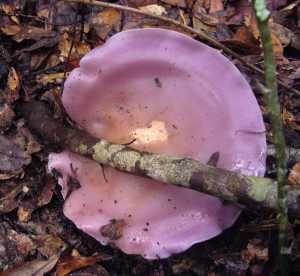
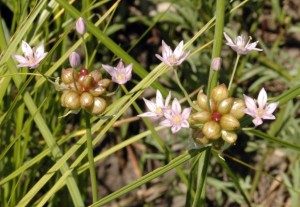
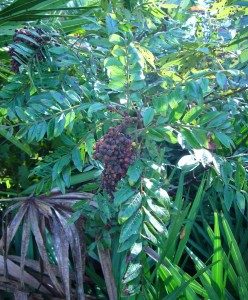
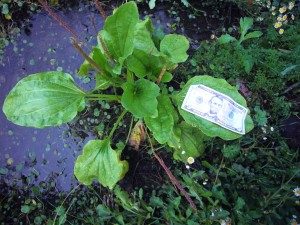
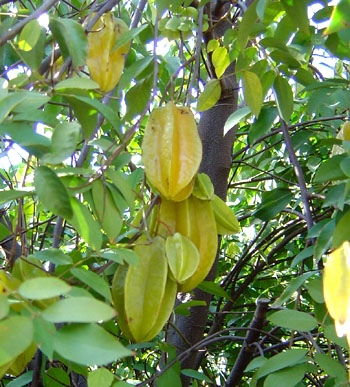

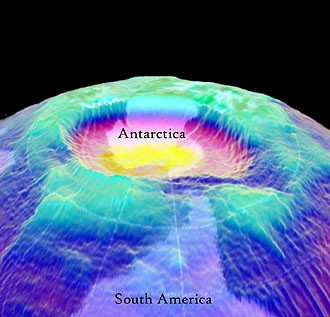
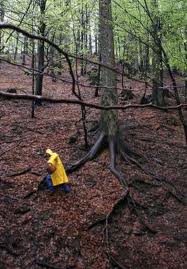
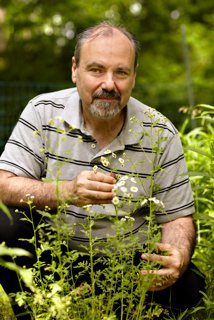
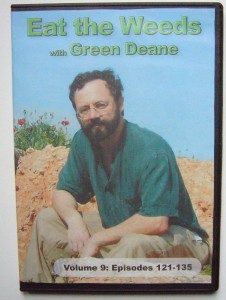
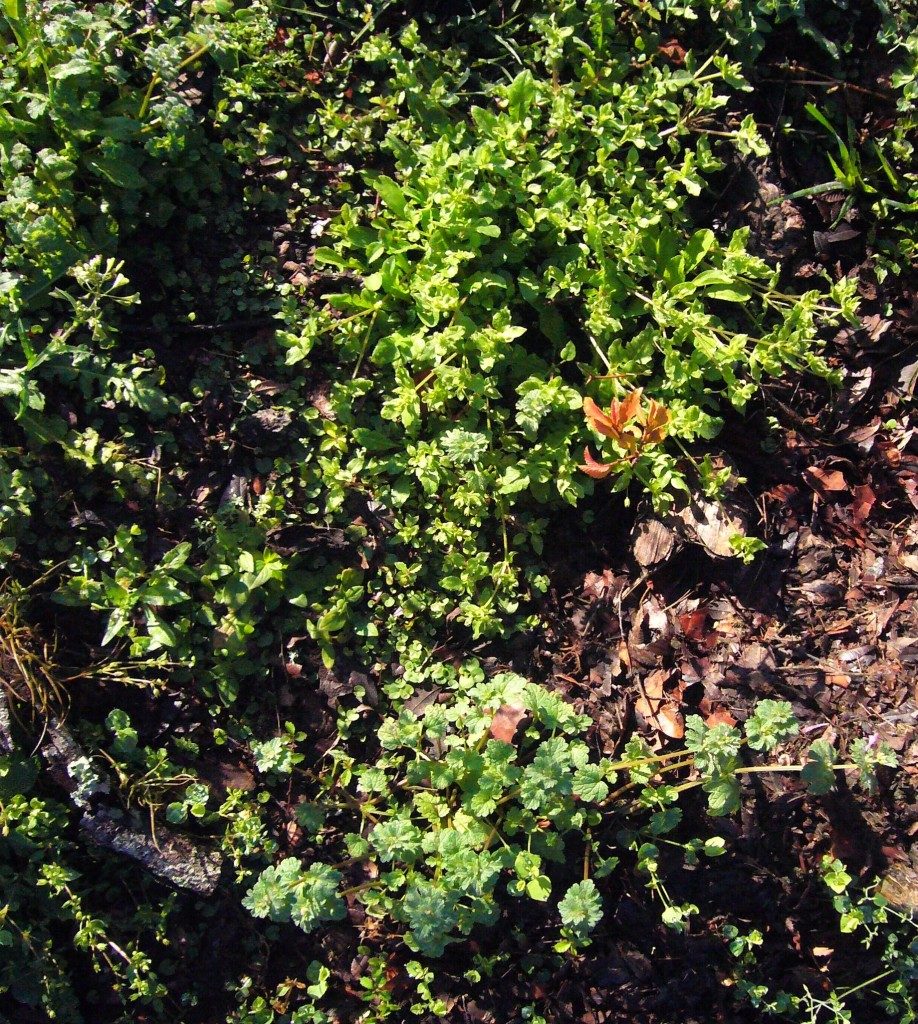
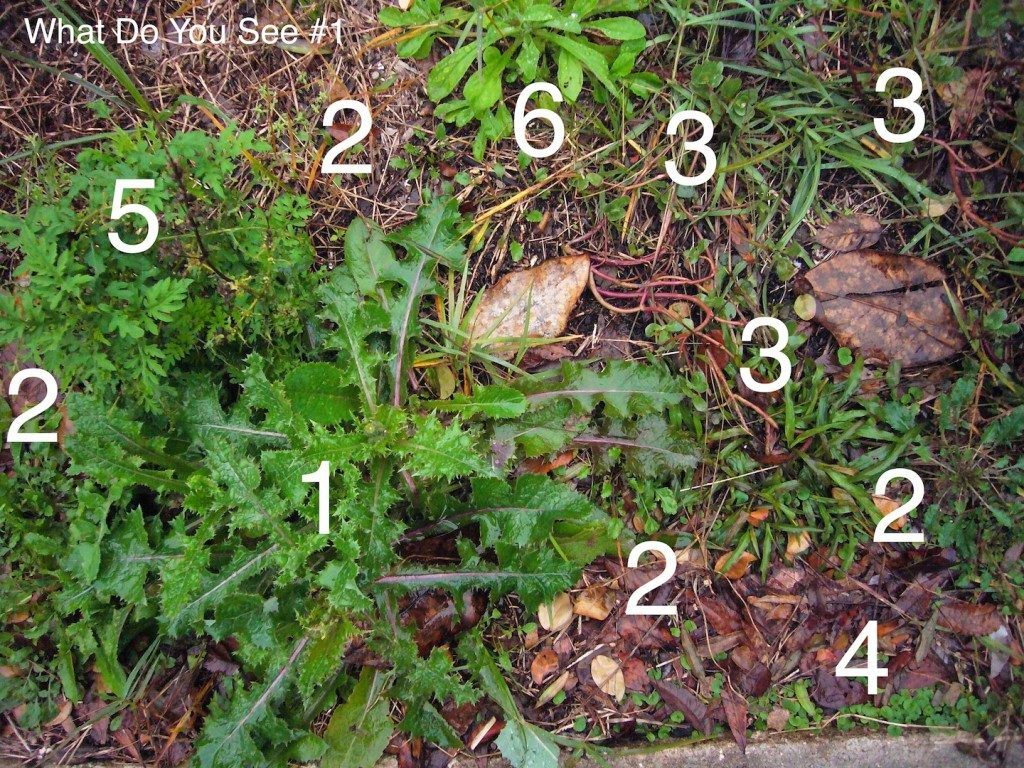

Great seeing you at the Earthskills Gathering. The mushroom guys were great… wish I could’ve attended one of their walks but I was teaching at the same time. A couple of folks who had missed your teaching asked after you when I was there Sunday. I told them you were teaching a class in Ocala and to check EattheWeeds.com for upcoming classes. It blew my mind how many edibles you were able to uncover at Jervey Gannt Rec. Park when I brought my kids down there to see you last year. Keep up the good work.
Hi
Re: climate change
you might want to look at this:
pretty convincing
http://www.suspicious0bservers.org/cliemate/
I did not write the article. It was a guest article by Mike Conroy.
Thank you for the link Bob. While I didn’t have room to discuss everything about global climate change, there is a huge amount of information both pro and con for the arguments.
Fungi are a nice addition to your newsletter.
Dear Green Dean,
I have been a “weed eater” since the mid 40’s and enjoy reading articles from folks like yourself. You seem to be one with the earth, and I have no doubt that your concerns for the well being of this planet are sincere and real.
However, to imply that global warming (or the soft touch “climate change”) may not be happening, or that it is not human caused, is truly putting your head in the sand. The “selected scientists” that you have labeled happen to be the most renowned and trusted individuals on the planet. Those who still publicly question the facts are the scientists who work for, or are paid off by the Big oil and Big coal corporations.
So my reply to your article is Yes. It is global warming, and we humans are the cause.
I did not write the article. It was a guest article by Mike Conroy.
Doug,
I appreciate everyone’s stance on the issue of climate change. While I cannot deny that, since there are many more people in the world today, there is the resultant increase in pollution that we must moderate, I also cannot claim that any climate change over a 50 year cycle is a result of said pollution.
Does the climate change? Sure! Are we hotter or colder than before? Depends on when you look at history. Global warming has been going on since the last ice age – before big oil and before the industrial revolution. The question for me is, is this a natural cycle or man made? And, again, for me, there is insufficient evidence to support either side of the argument.
Also, as I stated in the article, whether this is man made global climate change or not, there is cause for us to clean up our pollution. After all, who wants to live in a world of sewer water and land dump air?
Keep up the great job of thinking for yourself! It is a much admirable trait.
Thank you for the contribution by Mike Conroy. It is a refreshing, realistic opinion of what is going on in our world. Nature is, well…Nature. It’s our job to enjoy, protect and tend our ‘home’…not to run through life trying to change it. We can’t.
Green Deane, thank you so much for sharing your knowledge. You are a great resource for us!
Well Lysa,
It is possible that we can change it. After all, we have stressed the ocean seafood sources to the point that we must start investigating more intensive ways to farm seafood proteins or risk destroying that resource.
Question everything, investigate thoroughly, especially if it is “news”. In this case, time will tell whether it is man made or a cycle of nature. But we must, as you pointed out, police our pollution in order to know for sure.
Green Gene.
It is likely that God has seen bad change on Earth, what with all the chemicals and such being sprayed on plants plus all the chemicals added to the seeds before they are packaged and sold and he (God) wants to insure that people who are into Wild Edibles has a better and larger supply.
We never know what to expect from World Governments any longer.
Thank you and others for all that you do.
.
Thank you for the “what do you see?” series- great fun!
I see shepards purse, henbit, chickweed, those red leaves look like maybe blackberry leaves, and I think I see some baby dollar weed but I’d have to look closer.
The answer if you don’t want to wait until next week is on the Green Deane Forum under What Do You See?
I’d like to add my 2 cents worth in on Mike Conroy’s article. I had taken an “energy” class last semester in college. This makes me “no” expert by any means, but at least qualified to speak about this, within my education and knowledge level.
The facts are, global warming, or cooling for that matter, has occurred “naturally”, many times in Earth’s history. In fact, the Earth creates its own green house gasses by various natural ways (there are many types of green house gasses, even water vapor within the atmosphere is considered a green house gas).
Without these green house gasses, the Earth could not maintain enough heat for us to survive (green house gasses are not to be confused with ozone, or the ozone layer). Green house gasses simply blanket the Earth, and trap heat in our atmosphere. Every plant and animal depends on this heat, either directly or indirectly to survive. It sounds as if I do not believe man has anything to do with it doesn’t it? Read on.
Now, for the past 100 years or so (more so than any other period)?, man has been creating more, excess green houses gasses, discharged as waste, or exhaust. This waste collects and adds to the Earth’s own natural green house gasses. My class taught us that, it is becoming harder and harder for “man” to explain away its contribution.
Where I stand?, Well, man has done just that, “contributed” (to green house gasses), so therefore, man may not be the root cause of this global warming event, but man has “at the very least” helped to speed up the process. As for the extent of “how much”, good luck finding that truth. It depends who you ask.
That’s the facts. And don’t take my word for it, research it for yourself, and good luck researching the topic with all the millions of views, researches, opinions, studies, or whatever they label it.
Now, if you take the “contribution of green house gasses by man” out of the equation, (whether you believe it or not) like Mike Conroy pointed out, we’re still poisoning our planet with all these “man created” toxins. So, what will happen first, we burn up, shift climates, or get sick? Who knows.
What you will find, everywhere you look is opinions (so called scientific tests, reports, studies, etc.) “can” be determined by “man’s” special interests. So, sometimes, looking for the “truth” of a topic, can often be clouded by “ulterior motives” and “misinformation”. What to believe??? Figure that out for yourselves. But I do think it’s very irresponsible for “man” to continue to believe they are not doing anything wrong. Mankind definitely are not helping the matter any.
Good luck searching for the truth. But make sure, before you do, that it is the “truth” you are searching for, and not reinforcement for anyone’s opinion or interest. Information is altered, put in and left out for particular reasons.
But what do I know? lol
Great article there Barry! You are right, we are producing many more pollutants than anytime in history – we have many more people than ever before. And if we are to ever know what mans contribution to the current climate, we will have to keep these pollutants under control.
With respect to global warming , and if the graph shown is valid, one is tempted to suggest , based on the maxima the trend is towards lower ( though slight ) temperatures and what that would imply. Comparing a period of 60 years in perspective in geological time as only a moment , reminds me of the holy verse ” They ask you to hasten the punishment. Allah will not break the Promise. Each day with your Lord is like a thousand years in your reckoning, ” (Year = lunar year ) However, there is general agreement that man is to blame as he is abusing our planet. In this respect one should focus on the illiteracy of millions of people still in many parts of our world especially in poorer underdeveloped countries towards their understanding and interaction with the environment. These are the main contribution to the destruction of our world. Consequently aid is urgent to solve this problem instead of encouraging wars. ” Corruption has appeared on land and sea with what the hands of the people earned. Therefore they taste some of what they did in order that they return to righteousness. ” Holy verse…..As for Botany Builder #38, I’ve a typical example in my back garden which is Cassia orientalis as its flowers have been described as bright yellow, in erect stalked, axillary and terminal racemes.
The graph shown is valid as much as we can determine with the historical data we can glean from both historical records (written records) and from natural records (such as tree rings, core samples, etc.).
As for the religious side, this is about nature and natural cycles. I will not be arguing religion in any way. That is best left to a religion forum.
Thanks Farouk for your postings! I have seen your posts frequently.
I don’t want to add to discussion on global warming, but the reversal in the ozone hole was a result of an international ban on chemicals that act to enlarge the hole. This started in the 1970s and culminated with the Montreal Protocol of 1987. One could argue that the science was wrong and that the hole got smaller as a coincidence, I guess. But countries acted together to stop what appeared to all leading scientists to be a problem. The ozone hole *is* talked about today as a success story in international environmental policy.